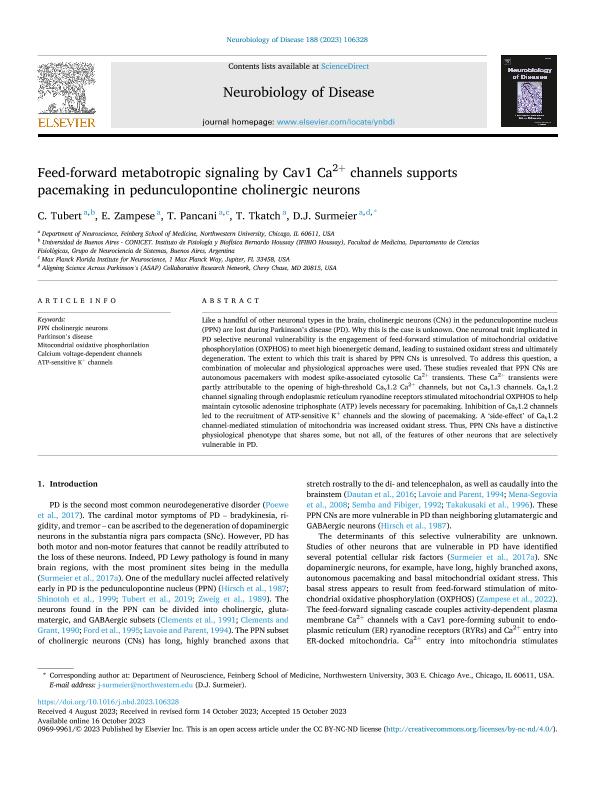Mostrar el registro sencillo del ítem
dc.contributor.author
Tubert, Cecilia

dc.contributor.author
Zampese, E.
dc.contributor.author
Pancani, T.
dc.contributor.author
Tkatch, T.
dc.contributor.author
Surmeier, D .J.
dc.date.available
2024-01-09T13:43:33Z
dc.date.issued
2023-11
dc.identifier.citation
Tubert, Cecilia; Zampese, E.; Pancani, T.; Tkatch, T.; Surmeier, D .J.; Feed-forward metabotropic signaling by Cav1 Ca2+ channels supports pacemaking in pedunculopontine cholinergic neurons; Academic Press Inc Elsevier Science; Neurobiology of Disease; 188; 11-2023; 1-14
dc.identifier.issn
0969-9961
dc.identifier.uri
http://hdl.handle.net/11336/223011
dc.description.abstract
Like a handful of other neuronal types in the brain, cholinergic neurons (CNs) in the pedunculopontine nucleus (PPN) are lost during Parkinson's disease (PD). Why this is the case is unknown. One neuronal trait implicated in PD selective neuronal vulnerability is the engagement of feed-forward stimulation of mitochondrial oxidative phosphorylation (OXPHOS) to meet high bioenergetic demand, leading to sustained oxidant stress and ultimately degeneration. The extent to which this trait is shared by PPN CNs is unresolved. To address this question, a combination of molecular and physiological approaches were used. These studies revealed that PPN CNs are autonomous pacemakers with modest spike-associated cytosolic Ca2+ transients. These Ca2+ transients were partly attributable to the opening of high-threshold Cav1.2 Ca2+ channels, but not Cav1.3 channels. Cav1.2 channel signaling through endoplasmic reticulum ryanodine receptors stimulated mitochondrial OXPHOS to help maintain cytosolic adenosine triphosphate (ATP) levels necessary for pacemaking. Inhibition of Cav1.2 channels led to the recruitment of ATP-sensitive K+ channels and the slowing of pacemaking. A ‘side-effect’ of Cav1.2 channel-mediated stimulation of mitochondria was increased oxidant stress. Thus, PPN CNs have a distinctive physiological phenotype that shares some, but not all, of the features of other neurons that are selectively vulnerable in PD.
dc.format
application/pdf
dc.language.iso
eng
dc.publisher
Academic Press Inc Elsevier Science

dc.rights
info:eu-repo/semantics/openAccess
dc.rights.uri
https://creativecommons.org/licenses/by-nc-nd/2.5/ar/
dc.subject
ATP-SENSITIVE K+ CHANNELS
dc.subject
CALCIUM VOLTAGE-DEPENDENT CHANNELS
dc.subject
MITOCONDRIAL OXIDATIVE PHOSPHORILATION
dc.subject
PARKINSON'S DISEASE
dc.subject
PPN CHOLINERGIC NEURONS
dc.subject.classification
Neurociencias

dc.subject.classification
Medicina Básica

dc.subject.classification
CIENCIAS MÉDICAS Y DE LA SALUD

dc.title
Feed-forward metabotropic signaling by Cav1 Ca2+ channels supports pacemaking in pedunculopontine cholinergic neurons
dc.type
info:eu-repo/semantics/article
dc.type
info:ar-repo/semantics/artículo
dc.type
info:eu-repo/semantics/publishedVersion
dc.date.updated
2024-01-09T10:45:43Z
dc.journal.volume
188
dc.journal.pagination
1-14
dc.journal.pais
Estados Unidos

dc.description.fil
Fil: Tubert, Cecilia. Consejo Nacional de Investigaciones Científicas y Técnicas. Oficina de Coordinación Administrativa Houssay. Instituto de Fisiología y Biofísica Bernardo Houssay. Universidad de Buenos Aires. Facultad de Medicina. Instituto de Fisiología y Biofísica Bernardo Houssay; Argentina
dc.description.fil
Fil: Zampese, E.. Northwestern University; Estados Unidos
dc.description.fil
Fil: Pancani, T.. Northwestern University; Estados Unidos
dc.description.fil
Fil: Tkatch, T.. Northwestern University; Estados Unidos
dc.description.fil
Fil: Surmeier, D .J.. Northwestern University; Estados Unidos
dc.journal.title
Neurobiology of Disease

dc.relation.alternativeid
info:eu-repo/semantics/altIdentifier/doi/http://dx.doi.org/10.1016/j.nbd.2023.106328
Archivos asociados
